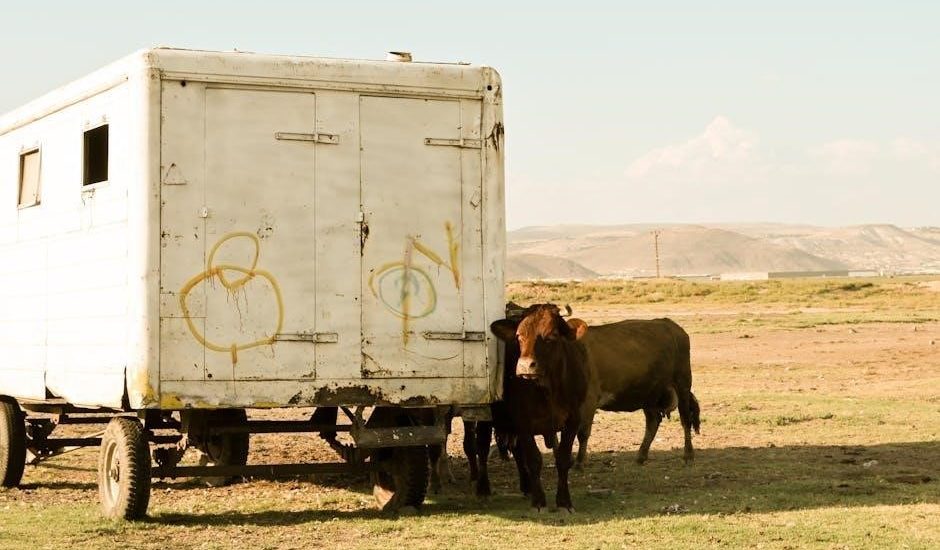A well-designed hay wagon plan is essential for creating a durable and functional farm utility. Detailed guides provide step-by-step instructions, ensuring a sturdy and reliable build for years of use.
Overview of Hay Wagon Designs
Hay wagon designs vary from traditional to modern, offering versatility for farm needs. Plans often include adjustable racks, reinforced flooring, and durable materials for long-term use. Customizable options allow farmers to tailor wagons to specific requirements, ensuring efficient hay transport. Many designs emphasize simplicity and practicality, making them easy to construct and maintain. Whether for small-scale or large operations, these plans provide a reliable solution for hay management. Detailed instructions guide builders through assembly, ensuring a sturdy and functional final product.
Importance of Detailed Plans for Construction
Detailed plans are crucial for building a hay wagon, ensuring structural integrity and functionality. They provide clear instructions, minimizing errors and saving time. Measurements, materials, and assembly steps are outlined, helping even novice builders achieve professional results. Proper plans also enhance safety by ensuring the wagon can handle heavy loads without failing. Without clear guidance, construction risks include instability, wasted materials, and potential safety hazards. A well-designed plan guarantees a durable and efficient hay wagon, making it an essential investment for any farming or agricultural project.
Key Features of a Functional Hay Wagon
A functional hay wagon should include sturdy flooring, durable side panels, and a reliable rack system for securing bales. It must have a solid frame to support heavy loads and withstand rough terrain. Openings for easy loading and unloading are essential, along with a stable axle system for smooth movement. Durable materials, such as oak or treated lumber, ensure longevity. The design should also allow for customization, like adjustable racks or additional storage compartments, enhancing versatility for various farm tasks. These features collectively ensure efficiency, safety, and long-term reliability in agricultural operations.
Design Considerations for Hay Wagons
Durability, weight distribution, and ease of use are critical in hay wagon design. Rack systems and material choices significantly impact functionality and longevity, ensuring efficient farm operations.
Choosing the Right Materials for Durability
Selecting the right materials is crucial for building a long-lasting hay wagon. Oak and pine are popular choices due to their strength and resistance to weather conditions. Metal reinforcements, such as bolts and screws, ensure structural integrity. Proper wood treatment and sealing can enhance durability, protecting the wagon from rot and insect damage. Durable materials not only extend the wagon’s lifespan but also ensure it can handle heavy loads without compromising safety. Investing in high-quality lumber and hardware is essential for a reliable and efficient hay wagon.
Understanding the Role of Rack and Rack Holder Design
The rack and rack holder design are critical components of a hay wagon, ensuring efficient loading and unloading of hay bales. A sturdy rack system prevents bales from shifting during transport, reducing the risk of damage or loss. Properly spaced and angled holders maximize storage capacity while allowing easy access. Durable materials and secure fastening methods are essential to withstand heavy loads and harsh farm conditions. A well-designed rack system enhances overall functionality, making it a key feature to focus on during the construction process for optimal performance and longevity.
Optimizing Space for Maximum Hay Capacity
Efficient hay wagon designs maximize storage by utilizing vertical space and strategically arranging bales. Plans often include tiered layouts or adjustable dividers to accommodate different bale sizes. Side and front openings, as seen in models like the WISC. 73 EX. 6173, allow easy loading and unloading. Rack systems with multiple levels ensure optimal use of space, while durable materials like rough-cut oak timbers provide structural support. Proper spacing between racks prevents overcrowding, ensuring each bale is securely stored without damage. These design elements help achieve maximum capacity while maintaining ease of access and operational efficiency for farmers and agricultural operations.
Materials and Tools Required
Constructing a hay wagon involves durable materials like rough-cut oak timbers and essential tools such as welders, saws, and drills. Proper equipment ensures a sturdy build.
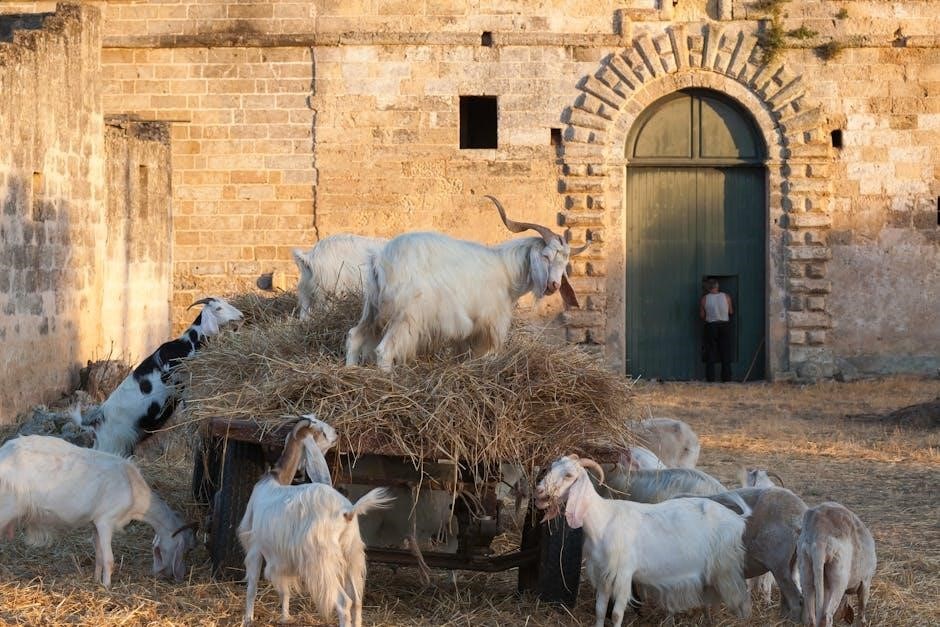
Essential Lumber and Hardware for Construction
Building a hay wagon requires high-quality lumber, such as 4x6x16 rough-cut oak timbers for the frame and 4x4s for support beams. Hardware includes heavy-duty bolts, screws, and metal brackets to ensure durability. Proper materials like weather-resistant wood and rust-proof fasteners are crucial for longevity. Sourcing these from trusted sawmills or suppliers guarantees strength and reliability. Additionally, tools like drills, saws, and wrenches are necessary for assembly. Following detailed plans ensures all components are correctly measured and fitted, resulting in a sturdy and functional hay wagon designed to withstand heavy use and harsh outdoor conditions.
Tools Needed for Assembly and Painting
Essential tools for assembling and painting a hay wagon include drills, impact wrenches, saws, and sanders. For painting, use high-quality brushes, rollers, or a paint sprayer for even coverage. Weather-resistant finishes are recommended to protect the wood. Clamps and workbenches aid in holding pieces steady during assembly. Safety gear like gloves and goggles is crucial. Proper tools ensure a smooth, efficient build and a durable finish. Detailed plans often list specific tools needed, helping builders prepare in advance. Investing in the right tools guarantees professional results and longevity for the hay wagon.
Sourcing Materials from Sawmills or Suppliers
Sourcing high-quality materials is crucial for building a durable hay wagon. Visit local sawmills for rough-cut lumber like oak timbers, ideal for frames and sills. Suppliers often provide hardware such as bolts, screws, and axles. Ensure materials are weather-resistant for outdoor use. Compare prices and quality from multiple sources to find the best options. Detailed plans often specify the exact materials needed, making it easier to shop efficiently. Building relationships with suppliers can also help secure better deals and faster delivery times, ensuring your project stays on track.
Step-by-Step Construction Guide
A detailed guide outlines assembling frames, installing racks, and attaching wheels. Each step ensures a sturdy and functional hay wagon, built efficiently and safely.
Assembling the Frame and Sill
Start by constructing the frame using durable materials like rough-cut oak timbers. Bolt the main sills longitudinally to the running gear, ensuring alignment and stability. Secure the frame with heavy-duty bolts for strength and longevity. Attach side sills to the main frame, ensuring proper fit and alignment. Use brackets to reinforce connections for added durability. Sand all surfaces to ensure smooth assembly and prevent splinters. Follow detailed plans to achieve precise measurements and a sturdy base for the hay wagon. Proper assembly of the frame and sill ensures a solid foundation for the entire structure.
Building the Flooring and Sides
Construct the flooring using 2×6 or 2×8 planks, spaced evenly for drainage and durability. Secure these planks to the sills using lag screws. For the sides, install vertical posts at each corner and along the length for support. Attach horizontal rails between the posts using wood screws. Ensure the sides are sturdy to hold heavy hay loads. Consider adding front and side openings for easy access. Sand all edges for safety and apply a sealant to protect the wood. Follow the plans carefully to ensure proper alignment and structural integrity of the flooring and sides.
Installing the Rack System
The rack system is crucial for holding hay bales securely. Begin by attaching vertical rack holders to the wagon’s sides using heavy-duty bolts. Ensure they are evenly spaced to distribute weight evenly. Next, place horizontal racks across the holders, securing them with screws. Consider adding a front and side opening feature for easy loading and unloading. Use galvanized hardware to prevent rust. Sand all surfaces for smooth operation and apply a protective finish. Proper installation ensures the rack system is both durable and functional, making your hay wagon efficient for transporting hay across the farm. Follow the plan precisely for optimal results.
Attaching Wheels and Axles
Attaching wheels and axles is a critical step for mobility. Secure the axle to the wagon frame using heavy-duty bolts, ensuring proper alignment with the chassis. Install wheels, making sure they rotate smoothly without wobbling. Use galvanized or rust-resistant hardware to withstand outdoor conditions. Tighten all connections firmly and test the wheels for stability. Consider adding grease fittings for axle maintenance. Proper installation ensures the wagon moves efficiently and safely, handling heavy loads without compromising structural integrity. Follow the plan’s specifications for precise measurements and alignment to achieve optimal performance and durability for your hay wagon.
Painting and Finishing the Wagon
Painting and finishing the wagon protects it from weather damage and enhances durability. Start by sanding all surfaces to ensure a smooth finish. Apply a primer if using metal components to prevent rust. Use high-quality, weather-resistant paint suitable for outdoor use. Allow each coat to dry completely before applying additional layers. Consider adding a clear sealant for extra protection. Detailed painting guides often accompany hay wagon plans, providing color schemes and design ideas. Proper finishing ensures the wagon remains functional and visually appealing for years, withstanding heavy use and harsh outdoor conditions.

Cost Estimation and Budgeting
Estimate material costs, including lumber and hardware, to budget effectively. Labor and tool expenses should also be considered. Compare supplier prices to optimize spending and stay within budget.
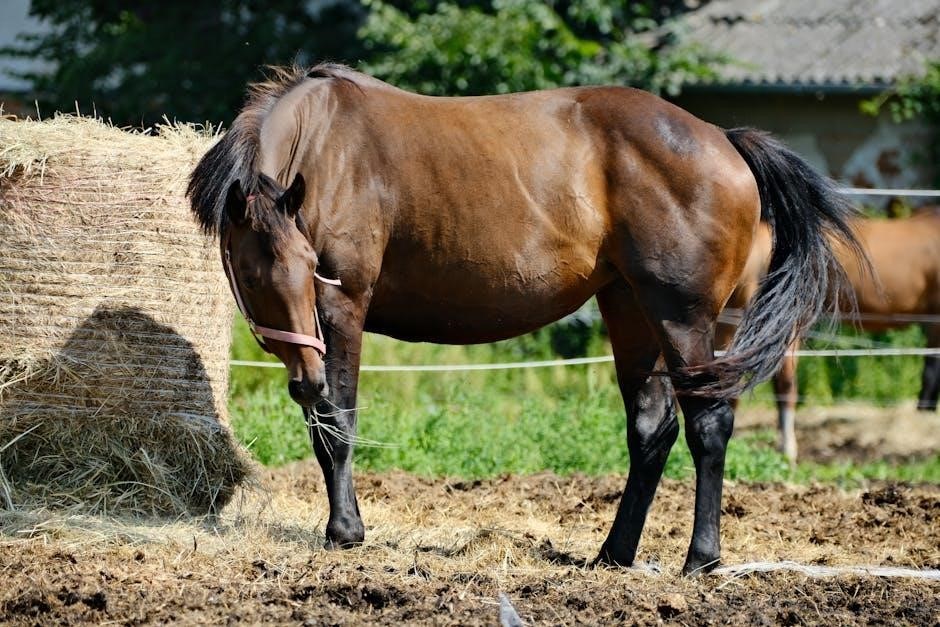
Calculating Material Costs
Accurately calculating material costs is crucial for budgeting. Start by listing all required lumber and hardware, such as oak timbers, bolts, and fasteners. Research current prices at local sawmills or suppliers, as costs can vary. Consider bulk purchases for discounts. Factor in the cost of tools if they are not already available. Additionally, account for paint and finishing materials. A detailed list ensures no expenses are overlooked. Compare prices from multiple sources to optimize spending. Plan for contingencies to avoid budget overruns. This step ensures the project remains financially manageable and aligns with your resources.
Estimating Labor and Time
Estimating labor and time for building a hay wagon requires careful planning. Break the project into phases, like framing, flooring, and rack installation, and allocate time based on complexity and skill level. Set realistic deadlines to maintain momentum, especially for first-time builders who may need extra time for adjustments. Organize tasks efficiently to minimize downtime and ensure regular inspections to address issues promptly. Experienced builders will move faster, while novices should allow additional time for learning. Keeping tools and materials organized prevents delays, helping the project stay on schedule and within budget.
Comparing Prices for Hardware and Tools
Comparing prices for hardware and tools is crucial for budgeting. Research suppliers, sawmills, and online retailers to find the best deals on lumber, bolts, and other essentials. Consider bulk purchases for cost savings and check for discounts on tools like drills or wrenches. Local hardware stores may offer competitive pricing, while online platforms provide convenience. Shipping costs and delivery times should also be factored in. Additionally, compare prices for alternative materials or tools that could reduce expenses without compromising quality. This step ensures your hay wagon build remains cost-effective and aligns with your budget constraints.

Time Management for the Build
A structured plan is key to efficiently managing time. Break the project into phases, set realistic deadlines, and minimize downtime to ensure timely completion of your hay wagon.
Breaking Down the Project into Phases
Start by preparing materials like 4x6x16 oak timbers and bolts. Phase 1: Assemble the frame. Phase 2: Build the flooring and sides. Phase 3: Install the rack system. Phase 4: Attach wheels and axles. Phase 5: Paint and finish. Detailed plans guide each step, ensuring a smooth process. Allocate time for cutting, assembling, and drying. This structured approach keeps the project organized and manageable, avoiding delays and ensuring a sturdy hay wagon.
Setting Realistic Deadlines
Begin by assessing the project’s complexity and your availability. Allocate 2-4 weeks for a basic hay wagon, depending on experience. Break the build into manageable phases: frame assembly (3-5 days), flooring and sides (2-3 days), rack installation (2-3 days), and painting (2-3 days). Larger wagons may require 6-8 weeks. Consider material preparation and drying times. Detailed plans and video tutorials can help streamline the process. Set flexible deadlines to accommodate unexpected delays. Prioritize quality over speed to ensure durability. With proper planning, you can complete your hay wagon efficiently and effectively.
Minimizing Downtime During Assembly
Organize materials and tools beforehand to avoid delays. Use a checklist to ensure all components are ready; Pre-drill holes and prepare hardware in advance. Clear instructions and detailed plans help maintain momentum. Sand or cut lumber ahead of time to streamline assembly. Regular inspections during construction catch issues early. Keep a well-stocked workshop to avoid trips for supplies. Watch video tutorials to understand complex steps. By staying organized and prepared, you can minimize downtime and complete your hay wagon efficiently, ensuring a smooth and successful build.

Safety and Maintenance Tips
Always wear protective gear during construction and use. Regularly inspect the wagon for wear and tear. Lubricate moving parts to ensure smooth operation and longevity of the wagon.
Safety Precautions During Construction
Always wear safety glasses, gloves, and a dust mask when cutting or sanding wood. Use steel-toe boots to protect feet from heavy tools or falling materials. Ensure proper ventilation when painting or using chemicals. Keep loose clothing tied back and avoid jewelry that could catch on tools. Maintain a clean workspace to prevent tripping hazards. Use proper lifting techniques to avoid back strain; Double-check all power tool settings before operation. Keep children and pets away from the work area. Regularly inspect tools for damage and ensure all blades are sharp for precise cuts. Follow all safety guidelines to prevent accidents and ensure a successful build.
Maintenance Tips for Longevity
Regularly inspect and tighten all bolts and screws to prevent loosening over time. Apply a waterproof sealant to protect wooden components from rot and moisture damage. Lubricate axles and moving parts annually to ensure smooth operation and reduce wear. Check for signs of wear on tires and replace them if necessary. Clean the wagon thoroughly after each use to remove dirt and debris. Store the wagon in a dry, shaded area during off-seasons to prevent sun damage. Address any repairs promptly to avoid minor issues becoming major problems. Proper maintenance ensures your hay wagon remains reliable and durable for years of service.
Regular Inspections for Wear and Tear
Regular inspections are crucial to identify and address wear and tear on your hay wagon. Check the frame, axles, and tires for signs of damage or rust. Inspect the flooring and sides for rot or structural weaknesses. Look for loose bolts or screws and tighten them immediately. Examine the rack system for bending or breakage. Perform these checks after every 50 hours of use or at the end of each season. Addressing issues early prevents costly repairs and ensures safety. Replace worn parts promptly and consider lubricating moving components to extend their lifespan. Consistent inspections maintain the wagon’s reliability and performance.
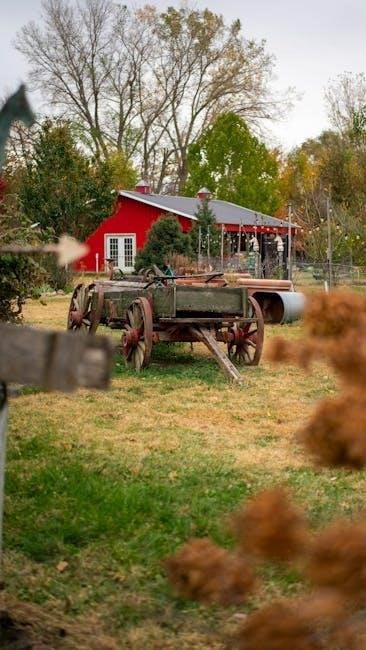
Examples and Case Studies
Farmers and builders share success stories of constructing hay wagons, showcasing innovative designs and practical solutions. Case studies highlight durability and functionality in real-world applications. Learn from their experiences.
Success Stories from Farmers and Builders
Farmers and builders have successfully constructed durable hay wagons using detailed PDF plans. Polyface Designs offers comprehensive guides, while a farmer extended their wagon’s running gear to 14 feet for better capacity. Builders share tips on materials and rack systems, ensuring longevity and efficiency. These real-world examples demonstrate how well-structured plans lead to functional and long-lasting hay wagons, meeting the needs of agricultural operations. Their experiences highlight the importance of careful design and construction, inspiring others to build reliable equipment for their farms.
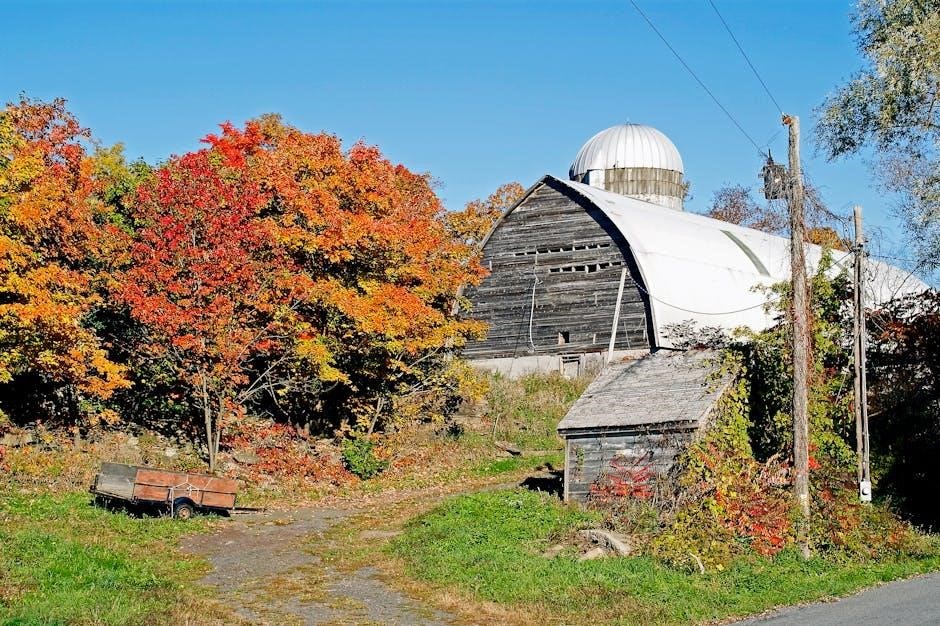
Lessons Learned from Previous Builds
Builders have learned valuable lessons from past hay wagon projects. One key takeaway is the importance of using durable materials, like rough-cut oak timbers, to ensure longevity. Others emphasize proper rack holder design to prevent structural weaknesses. Some builders regret not extending the wagon’s running gear for better capacity initially. Regular inspections and timely repairs have also proven crucial for maintaining functionality. These experiences highlight the value of detailed plans and the need for careful execution. By addressing common pitfalls, future builds can avoid costly mistakes and result in more efficient, long-lasting hay wagons for agricultural use.

Innovative Modifications and Upgrades
Builders have introduced creative upgrades to enhance hay wagon functionality. Adjustable rack systems improve versatility for different bale sizes, while side and front openings offer easier access. Durable materials like rough-cut oak timbers ensure longevity. Some innovators extend the running gear for larger capacity, while others repurpose wagons for alternative uses, such as transporting livestock. Custom painting options add a personal touch, and modifications like reinforced frames improve stability. These upgrades reflect the adaptability of hay wagon designs, catering to diverse needs and ensuring optimal performance in various agricultural settings. Such innovations keep hay wagons relevant and efficient for modern farming practices.
Resources and Further Reading
Explore detailed guides like Polyface Designs on Amazon for comprehensive construction plans. Online forums and communities offer valuable insights, while downloadable PDF templates provide practical, ready-to-use designs for hay wagon builds.
Recommended Books and Guides
For comprehensive insights, consider Polyface Designs, a detailed guide offering practical construction plans. Online resources like woodworking plans and farm equipment manuals provide step-by-step instructions. Additionally, downloadable PDF templates and construction blueprints are available, ensuring precise measurements and assembly methods. These resources cater to both novice and experienced builders, offering tips for customization and optimization. Hardware lists and assembly instructions are often included, making the building process streamlined and efficient. Leveraging these guides ensures a well-constructed hay wagon tailored to specific needs, combining functionality with durability for long-term use.

Online Communities and Forums
Online forums and communities offer invaluable resources for hay wagon builders. Platforms like YouTube, Pinterest, and farming forums feature detailed tutorials, modification ideas, and user experiences. Builders share insights on optimizing designs, troubleshooting common issues, and innovative upgrades. These spaces provide access to downloadable PDF plans, Assembly guides, and tips from experienced craftsmen. Engaging with these communities fosters collaboration and learning, helping builders refine their projects. From practical advice to creative solutions, online forums are a treasure trove for anyone aiming to construct a high-quality hay wagon tailored to their specific needs and preferences.
Downloadable PDF Plans and Templates
Downloadable PDF plans and templates provide detailed blueprints for constructing hay wagons. These resources often include comprehensive guides, material lists, and step-by-step instructions. Many plans feature customizable designs, allowing builders to adapt dimensions and features to suit their needs. Websites like Amazon and specialized farming forums offer access to these templates, ensuring a smooth construction process. Some plans also include helpful tips for optimizing space and durability. Whether you’re a novice or an experienced builder, downloadable PDFs offer a convenient and precise way to achieve professional-grade results for your hay wagon project.
A well-built hay wagon enhances farming efficiency and durability. With proper planning and execution, it becomes a valuable asset, offering years of reliable service and satisfaction.
Final Thoughts on Building a Hay Wagon
Building a hay wagon is a rewarding project that combines practicality with creativity. With detailed plans, you can create a durable, functional tool tailored to your needs. Ensure attention to material selection and design details like rack systems for longevity. Proper construction and maintenance will maximize efficiency on your farm or homestead. Whether for agriculture or recreation, a well-built hay wagon offers lasting value. First-time builders should embrace the challenge, as the end result will provide years of reliable service and satisfaction.
Encouragement for First-Time Builders
Embarking on your first hay wagon project can seem daunting, but with the right plans, it’s achievable. Start by following detailed guides and gathering all necessary materials. Break the project into manageable steps to avoid overwhelm. Don’t hesitate to seek advice from online communities or experienced builders. Patience and persistence will yield a sturdy, functional wagon. Remember, every project starts with a first step, and the sense of accomplishment upon completion is incredibly rewarding; Embrace the learning process and enjoy the journey of creating something truly useful for your farm or homestead.
The Value of a Well-Built Hay Wagon
A well-constructed hay wagon is more than just a farm tool—it’s an investment in efficiency and durability. A sturdy design ensures years of reliable service, reducing the need for frequent repairs. By following detailed plans, you create a wagon tailored to your needs, whether for heavy-duty hauling or smaller-scale operations. A high-quality hay wagon not only streamlines tasks but also adds value to your farm or homestead. The pride of owning a self-built, functional piece of equipment is unmatched, making it a worthwhile project for any farmer or builder.

